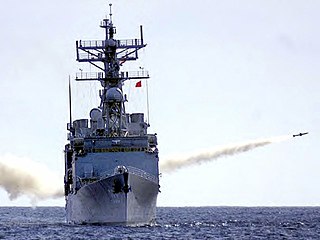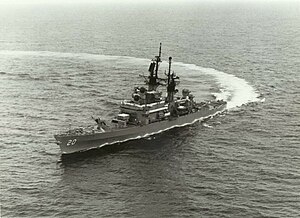
USS Cleveland (LPD-7), an Austin-class amphibious transport dock, was the third ship of the United States Navy to be named for the city in Ohio. Her keel was laid down at Ingalls Shipbuilding of Pascagoula, Mississippi. She was launched on 7 May 1966, and was commissioned on 21 April 1967 at Norfolk, Virginia. At the time of decommissioning, she was the third-oldest commissioned ship in the US Navy, behind USS Constitution and USS Enterprise.

USS McInerney (FFG-8), is a Oliver Hazard Perry class guided-missile frigate, in service with the United States Navy from 1979 to 2010. She was then transferred to the Pakistan Navy and entered service as Alamgir (F260) in early 2011.

USS Dale (DLG-19/CG-19) was a Leahy-class cruiser in service with the United States Navy from 1963 to 1994. She was sunk as a target in 2000 off the East Coast of the United States near Maryland.

USS Biddle/Claude V. Ricketts (DD-995/DDG-5), was a Charles F. Adams-class guided missile destroyer of the United States Navy. She was the third US Naval ship named after Nicholas Biddle, one of the first five captains of the Continental Navy.

USS Henry B. Wilson (DDG-7), named for Admiral Henry Braid Wilson, was a Charles F. Adams-class guided missile armed destroyer laid down by Defoe Shipbuilding Company in Bay City, Michigan on 28 February 1958, launched on 22 April 1959 sponsored by Mrs. Patrick J. Hurley, daughter of Admiral Wilson, and commissioned on 17 December 1960.

USS Ticonderoga (DDG/CG-47), nicknamed "Tico", was a guided-missile cruiser built for the United States Navy. She was the lead ship of the Ticonderoga class and the first U.S. Navy combatant to incorporate the Aegis combat system. Originally ordered as a guided-missile destroyer, she was redesignated as a cruiser after capabilities from the cancelled Strike cruiser program were implemented into the ship's design. The new AEGIS system allowed Ticonderoga to track and engage many aerial targets more effectively than any previous U.S. Navy warship.

USS Conyngham (DDG-17), the third ship named for Captain Gustavus Conyngham USN (1744–1819), was a Charles F. Adams-class guided missile armed destroyer in the United States Navy.

USS Bainbridge (DLGN-25/CGN-25) was a nuclear-powered guided missile cruiser in the United States Navy, one of only two ships of her class. Named in honor of Commodore William Bainbridge, she was the fourth US Navy ship to bear the name. With her original hull classification symbol of DLGN, she was the first nuclear-powered destroyer-type ship in the US Navy, and shared her name with the lead ship of the first US Navy destroyer class, the Bainbridge-class destroyers.

USS Bunker Hill (CG-52) is a Ticonderoga-class guided missile cruiser of the United States Navy constructed by Litton-Ingalls Shipbuilding Corporation at Pascagoula, Mississippi and launched on 11 March 1985. The Ticonderoga-class cruisers are equipped with the Aegis Combat System and Bunker Hill is the first of the class to be equipped with the Mark 41 Vertical Launching System (VLS) in place of the previous ships' twin-arm Mark 26 missile launchers, which greatly improved the flexibility and firepower of the ships by allowing them to fire BGM-109 Tomahawk cruise missiles for land attack missions. Other missions include ballistic missile defence and capital ship escort for anti-aircraft defense. The ship was commissioned on 20 September 1986 and is homeported at Naval Base San Diego in San Diego, California.

USS Paul F. Foster (DD-964), named for Vice Admiral Paul F. Foster USN (1889–1972), is a Spruance-class destroyer built by the Ingalls Shipbuilding Division of Litton Industries at Pascagoula, Mississippi. She was commissioned on 21 February 1976 and decommissioned on 27 March 2003. She is now ex-Paul F. Foster, serving as a Self Defense Test Ship for experimental U.S. Navy weapons and sensors.

USS Hewitt (DD-966), named for Admiral H. Kent Hewitt USN (1887–1972), was a Spruance-class destroyer built by the Ingalls Shipbuilding Division of Litton Industries at Pascagoula, Mississippi and launched on 14 September 1974 by Mrs. Leroy Hewitt Taylor and Mrs. Gerald Hewitt Norton, daughters of Admiral Hewitt.

USS Okinawa (LPH–3) was the second Iwo Jima-class amphibious assault ship of the United States Navy. She was the second Navy ship assigned the name "Okinawa", in honor of the World War II Battle of Okinawa.

USS Guadalcanal (LPH-7), the third Iwo Jima-class amphibious assault ship (helicopter), was launched by the Philadelphia Naval Shipyard 16 March 1963, sponsored by Zola Shoup, wife of General Shoup, the former Commandant of the Marine Corps; and commissioned 20 July 1963. It was the second ship in the Navy to bear the name.

USS New Orleans (LPH-11) was an Iwo Jima-class amphibious assault ship in the United States Navy. She was the third Navy ship to be so named, and is the first named for the Battle of New Orleans, which was the last major battle of the War of 1812.

USS Curts (FFG-38) was the twenty-ninth ship of the Oliver Hazard Perry-class of guided-missile frigates. She was named for Admiral Maurice Curts (1898–1976). Curts is the first ship of that name in the US Navy.

USS Mobile Bay (CG-53) is a Ticonderoga class guided-missile cruiser that served in the United States Navy from 1987 to 2023. She is named for the naval Battle of Mobile Bay during the American Civil War in 1864.

Strike Fighter Squadron 32 (VFA-32), nicknamed the "Fighting Swordsmen" are a United States Navy strike fighter squadron presently flying the F/A-18F Super Hornet and based ashore at Naval Air Station Oceana. Their radio callsign is Gypsy and their tail code is AC. The Fighting Swordsmen of VFA-32 are the 2023 recipients of the Mutha Fighter Spirit Award, awarded annually at the Navy’s Strike Fighter Ball in Norfolk, VA.

USS California (CGN-36), the lead ship of the California-class of nuclear-powered guided missile cruisers, was the sixth warship of the United States Navy to be named for the state of California. She was the last active nuclear-powered cruiser for the United States.

USS Fox (DLG-33/CG-33) was a Belknap class cruiser of the United States Navy, named after Gustavus V. Fox, President Abraham Lincoln's Assistant Secretary of the Navy. The keel for DLG-33 was authenticated and laid in ceremonies at Todd Shipyards, Los Angeles Division, San Pedro, California on 15 January 1963.

USS Ouellet (FF-1077) was a Knox-class frigate of the United States Navy. Ouellet was the first and only ship of the U.S. Navy to bear the name of Seaman David George Ouellet, a posthumous recipient of the Medal of Honor. The vessel was one of a class of frigates specifically designated to locate and destroy enemy submarines. The ship entered service in 1970 and was decommissioned in 1993. Ouellet was sold to Thailand in 1996 and renamed HTMS Phutthaloetla Naphalai.






















